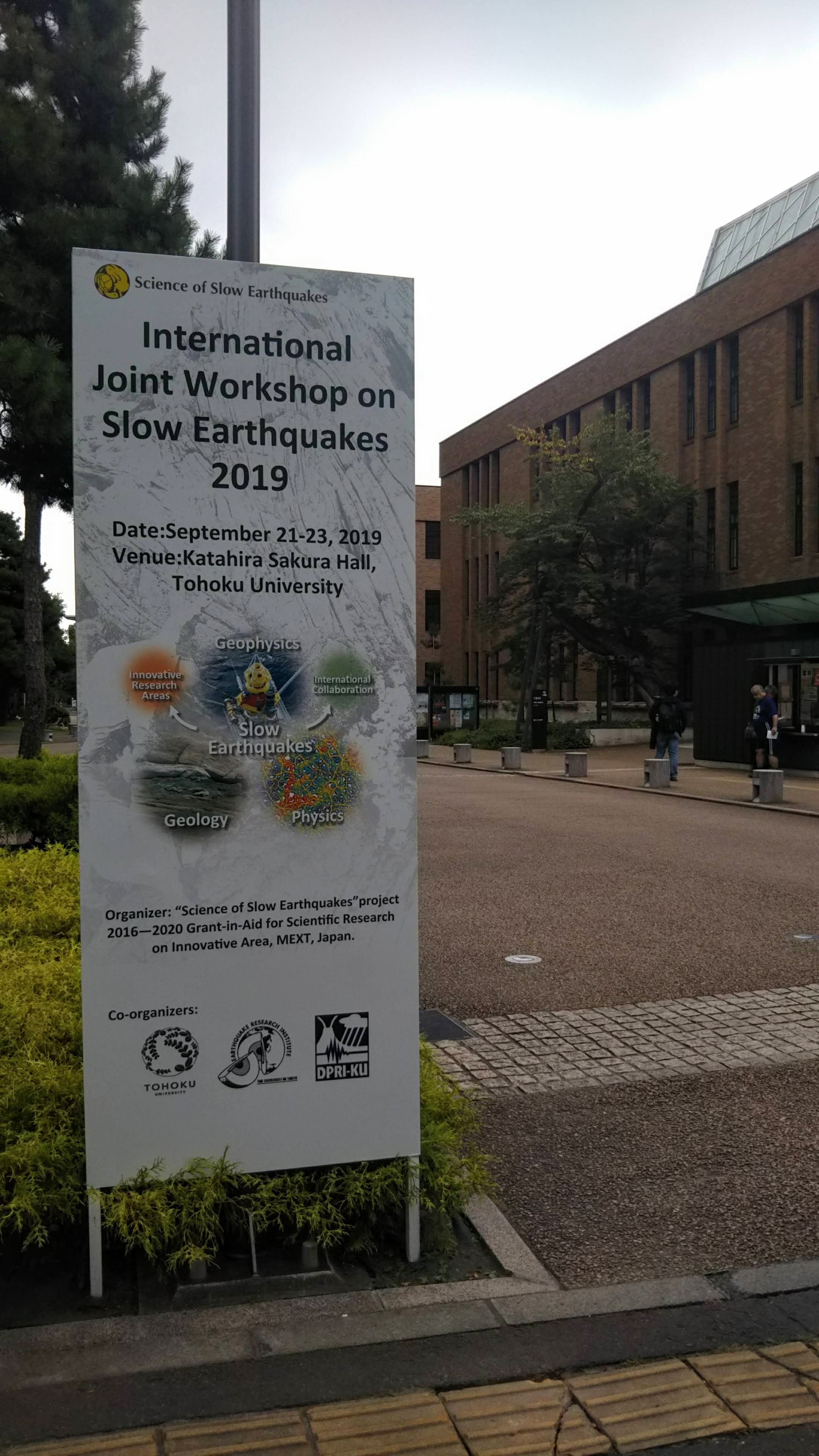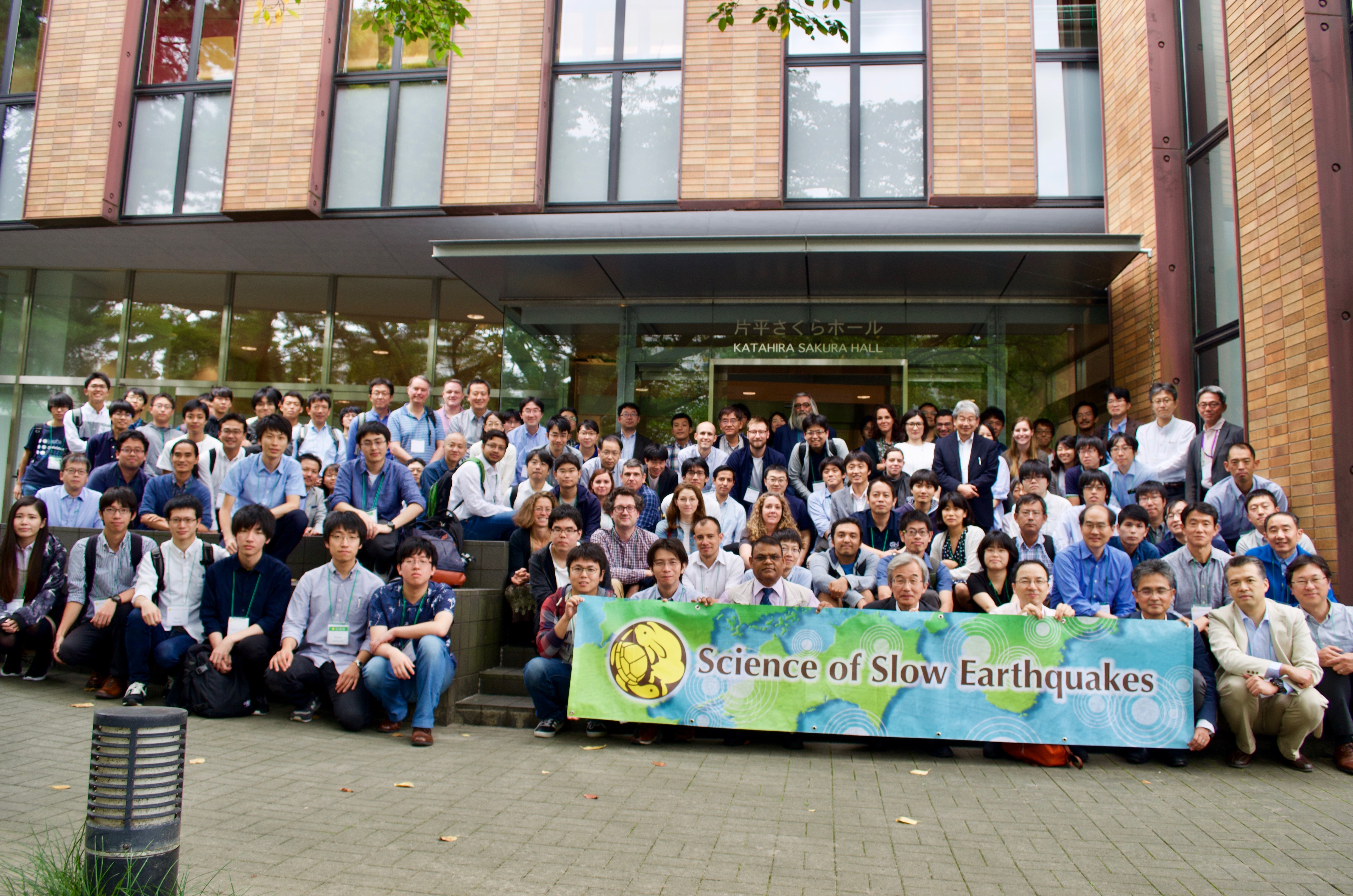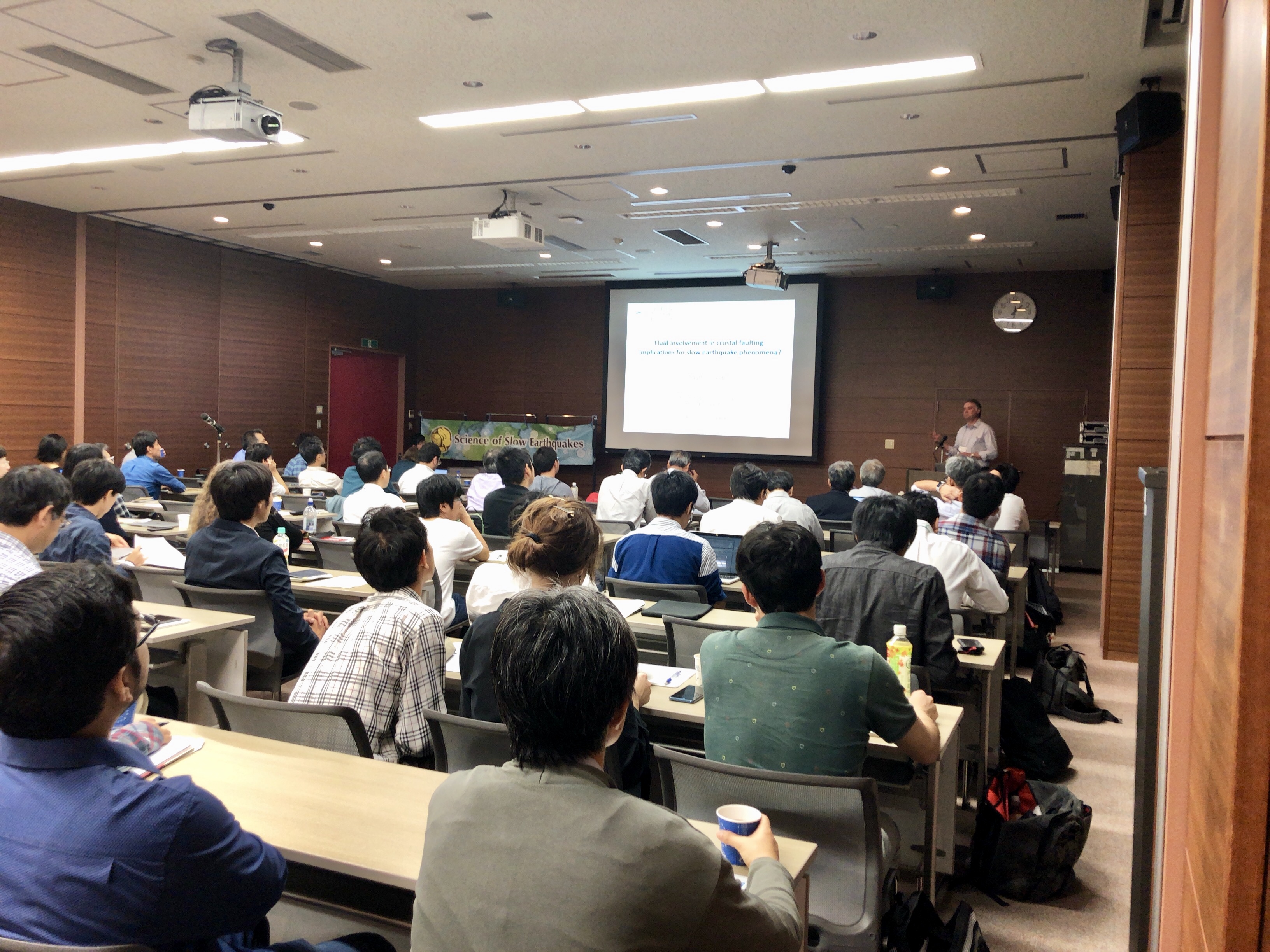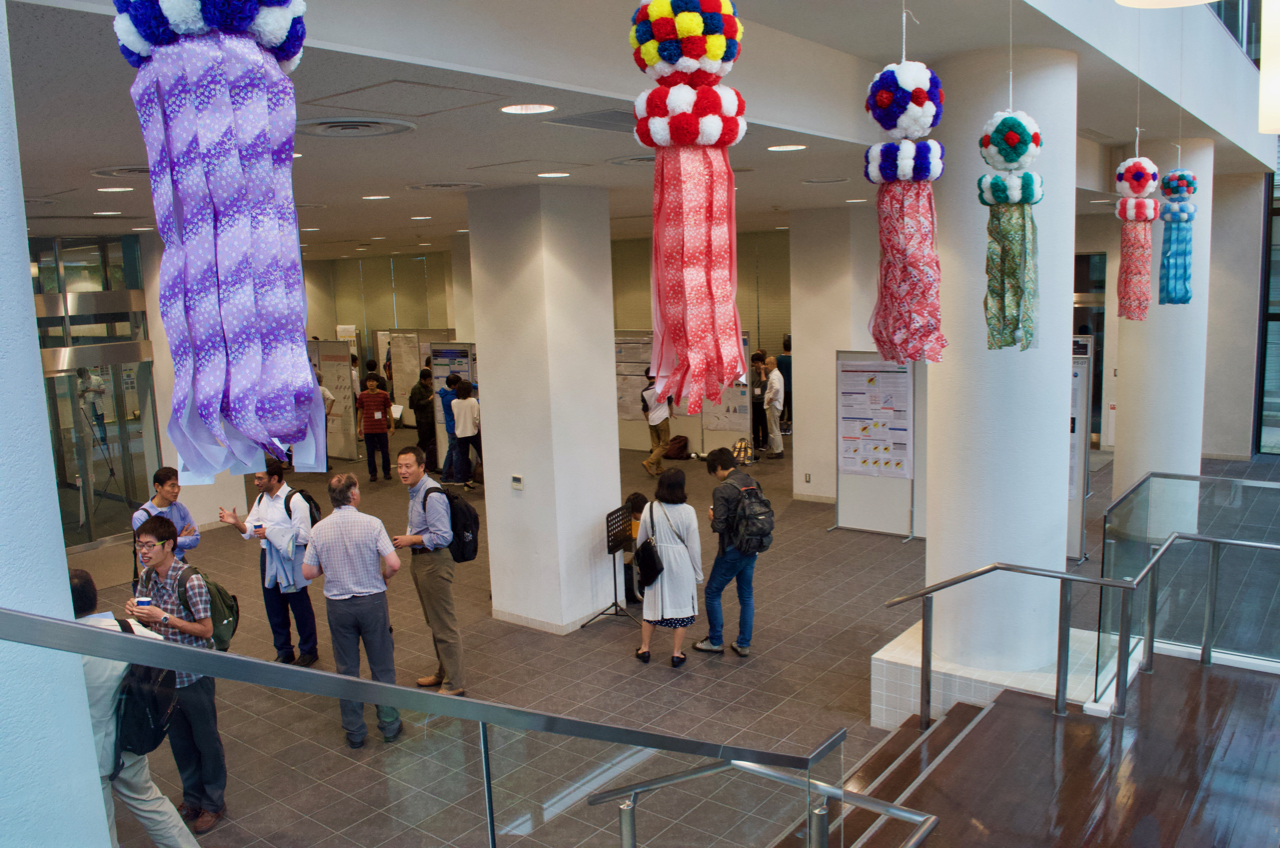Events / Activities2019
2019/12/09-13
Sessions at AGU Fall Meeting 2019
| Meeting | AGU Fall Meeting 2019 (Website) |
|---|---|
| Date | 2019/12/09-13 |
| Important Dates |
Abstract Submission Deadline: 2019/07/31 |
| Venue | Moscone Convention Center |
| Details | Sessions: Science of slow earthquakes: (Interplay between Seismic and Aseismic Slip on Seismogenic Faults) Conveners: Luca Dal Zilio, Suguru Yabe, Mario A Aurelio, Kate Huihsuan Chen |
2019/10/28-29
Workshop cancelled"1st International Workshop on Slow and Fast Earthquakes" co-organized by University of Chile and JSPS project "Science of Slow Earthquakes" will be held.
| Date | 2019/10/28-29 |
|---|---|
| Venue | University of Chile |
| Details | Workshop site Registration form is in the workshop site |
2019/10/21
The paper by Dr. Kohtaro Ujiie was published on Nature Geoscience.
2019/09/26
Slow Earthquakes Cafe
Prof. William Frank from University of Southern California will give a talk at ERI.
| Date/Time | 2019/09/26 (Thu.)16:00-17:30 (Refreshments will be served at 15:30) |
|---|---|
| Venue | Seminar room, 2nd floor, Bld. 1, ERI Access Map |
| Speaker | William Frank (University of Southern California) |
| Topic | The transient and intermittent nature of slow slip |
| Abstract | Slow slip in all its forms (slow slip, afterslip, and surface creep) is now recognized to play a significant role in releasing tectonic stress along plate boundary faults. Since the first observations of surface creep along the San Andreas plate boundary more than 50 years ago, advances in geophysical instrumentation and innovative observational approaches have revealed that faulting at major plate boundaries covers a broad spectrum of slip modes, from fast earthquake rupture to intermittent slow slip. While satellite imaging reveals the spatial complexity of slow slip, continuous GPS measurements and seismology reveals the jerky, intermittent nature of aseismic slip. |
2019/09/25
Slow to Fast: SEQ Cafe@Osaka
| Date | 2019/09/25 |
|---|---|
| Venue | F227, Building F, Faculty of Science, Osaka University(Access) |
| Program |
|
2019/09/21-23
International Joint Workshop on Slow Earthquakes 2019 will be held in Sendai city, Miyagi prefecture.
| Date | 2019/09/21-23 |
|---|---|
| Venue | Katahira Sakura Hall, Tohoku University (Access) |
| Details | Workshop site Registration form is in the workshop site WS2019 poster |




2019/09/04
The paper by Dr. Satoshi Ide was published on Nature.
2019/08/23
The paper by Dr. Tomoaki Nishikawa, et al. was published on Science Online.
2019/06/06-07
Workshop on rock friction, non-linear physics and slow earthquakes
| Date | 2019/06/06-07 |
|---|---|
| Venue | Nishijin Plaza, Kyushu University, Medium Conference Room(Access) |
| Scope | The Science of slow earthquakes has been shifting its direction from discovery and classification to understanding of the mechanisms behind them. In this workshop, we will discuss the connection between macroscopically observed slow earthquakes and lab-scale rock friction experiments. Furthermore, we will also seek possibilities of constructing mathematical models which describe various types of physical/chemical processes related to slow earthquakes. |
| Program |
Day 1
|
2019/06/03
Seminar(s) by Dr. Paul Selvadurai (ETH Zurich)
| Date/Time | 2019/06/03 14:30-17:00 |
|---|---|
| Venue | F524, Faculty of Science, Osaka University(Access) |
| Program | 14:30-15:30 (Part1) Seismologic estimates of energy flow during dynamic rupture: Benefits of laboratory settings to understand up-scaling processes 15:30-16:00 coffee break 16:00-17:00 (Part2) Worn fault surfaces and foreshocks: Modelling observed precursory seismicity in the laboratory with rate and state friction |
| Abstract | (Part1) Seismologic estimates of energy flow during dynamic rupture: Benefits of laboratory settings to understand up-scaling processes The study of large megathrust earthquakes have greatly benefited from the growing academy of geodetic instruments and methodologies. Large events appear to exhibit premonitory slow slip that persists over long time (years) and large lengths scales (kms). Studies have shown that these regions are prone to foreshocks, which, if better understood, could provide crucial information about the mainshock. Conditions that lead to foreshocks, or their location relative to the slow slip region, are currently impossible to predict with a degree of certainty. Moreover, once a foreshock rupture begins, little is known regarding possible traits in their seismic signatures that help us explain why they arrest and do not cascade-up into a 'mainshock'. Field observations of earthquakes, show that the ruptures begin to expand in a crack-like manner, accelerating outwards to a critical velocity, whereby they (may) transition to a pulse-like dynamic rupture. Whether a rupture transitions from a crack-like to pulse-like rupture mechanism is not well understood and may depend on numerous factors such as heterogeneous presence of barriers and asperities, which could help us explain foreshock behaviour. We investigated a laboratory direct shear experiment where a frictional fault was formed by pressing two mature (worn) surfaces of poly (methyl methacrylate) together, then subjecting it to shear, until a 'stick-slip' failure occurred. Prior to failure, spontaneous ruptures were found to nucleate within a region of accelerated slip, but arrested locally, on the faulting surface. A concerted study employed standard seismological tools to measure source properties, such as, magnitude, source radius and static stress drop. To reconcile these observations, we studied the postmortem surfaces and found that the worn fault displayed a clear bimodal Gaussian distribution of surface height. This is indicative of the existence of a preferentially smooth (polished) surface that was susceptible to rupture nucleation. This unique distribution was determined to be a proxy for a local description of the critical slip distance used in numerical calculation performed in a Quasi-DYNamic earthquake simulator (QDYN, Luo et al., 2017). Numerical calculations were validated by their ability to match the seismologically determined source properties. The validated model allowed us to study: (1) how the foreshocks initiated, (2) why they sometimes arrested, (3) their moment rate functions and (4) their spatial and temporal relationship to the hypocenter of other foreshocks and, more importantly, the impending mainshock. |
2019/05/26-30
Sessions at JpGU Meeting 2019
| Meeting | JpGU Meeting 2019 (Website) |
|---|---|
| Date | 2019/05/26-30 |
| Important Dates |
Abstract Submission Period: 2019/01/08-02/19 Early submission deadline: 11:59pm (JST) 2019/02/04 Early Registration Period: 2019/01/08-05/08 |
| Venue | Makuhari Messe, Chiba |
2019/05/20
Slow Earthquakes Cafe in Yokohama
Dr. Joan Gomberg of U.S. Geological Survey will give a talk at JAMSTEC, Yokohama.
| Date/Time | 2019/05/21 (Tue.)15:30-16:30 |
|---|---|
| Venue | Guesthouse at Yokohama Institute for Earth Sciences (YES), Japan Agency for Marine-Earth Science and Technology(JAMSTEC):Access Map (For security check, please make sure you arrive 10 minutes prior to the start of the seminar.) |
| Speaker | Dr. Joan Gomberg (U.S. Geological Survey) |
| Topic | "Exploring tectonic processes beneath the oceans using new seafloor observations" |
| Abstract | 20190520_Abstract_Gomberg.pdf |
2019/04/23-26
Sessions at 2019 SSA Meeting
| Meeting | 2019 SSA Meeting (Website) |
|---|---|
| Date | 2019/04/23-26 |
| Important Dates |
Abstract Submission Deadline: 2018/12/01-2019/01/11 Program and Abstracts Online: 2019/02/15 Exhibitor Registration Closes: 2019/03/01 Meeting Pre-Registration Deadline: 2019/03/18 Hotel Reservation Deadline: 2019/03/30 Online Registration Deadline: 2019/04/05 |
| Venue | The Westin in Seattle, Washington |
| Details | Sessions: Science of slow earthquakes: Toward unified understandings of whole earthquake process Convener: Kazushige Obara, Kenneth C. Creager, Heidi Houston, Takanori Matsuzawa Session Description: Recognition of slow earthquake phenomena originated in Cascadia and Japan. Since the discovery of slow earthquakes, their study has continued to advance rapidly. Discussion in this joint session with Seismological Society of Japan (SSJ) is proposed to advance understanding of the phenomena not only in these two zones, but in many subduction zones around the Pacific Ocean, as well as other tectonic settings. The proximity of slow slip phenomena in subduction zones to great megathrust earthquakes highlights the importance of this topic for seismic hazard. The goal of the session is to bring together research on slow earthquake phenomena that uses a variety of tools from seismology, geodesy, numerical modeling and laboratory studies, for various tectonic settings and spatial and temporal scales. This session is jointly organized by the Seismological Society of Japan and SSA. |

